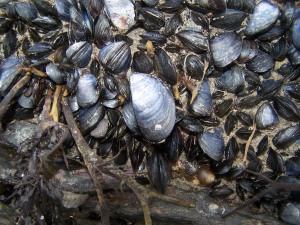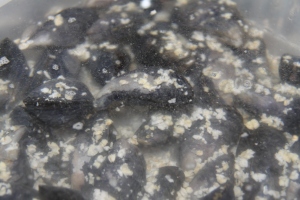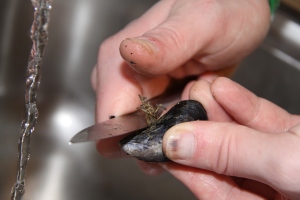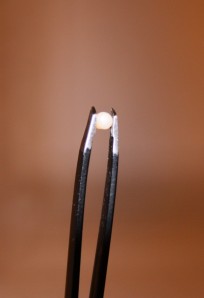 Hopefully, my last post – Wild Mussels vs. ‘Farmed’ Mussels – managed, in its funny little way, to persuade you that gathering wild Mussels is still a great idea, despite there being no real benefits for either the cook or the environment (though there certainly isn’t anything harmful either). As I state on my About this Blog page, foraging isn’t about convenience – it’s about discovery. And if you’ve discovered the fun of foraging for some of the free fruits-de-mer available to us all, perhaps you’d now like to discover the simple skills of how to render them as grit-free as possible in preparation for the pot.
Hopefully, my last post – Wild Mussels vs. ‘Farmed’ Mussels – managed, in its funny little way, to persuade you that gathering wild Mussels is still a great idea, despite there being no real benefits for either the cook or the environment (though there certainly isn’t anything harmful either). As I state on my About this Blog page, foraging isn’t about convenience – it’s about discovery. And if you’ve discovered the fun of foraging for some of the free fruits-de-mer available to us all, perhaps you’d now like to discover the simple skills of how to render them as grit-free as possible in preparation for the pot.
De-bearding Mussels
Mussels attach themselves to rocks via thick black beard-like fibres called byssal threads. These are not very tasty at all and will need to be removed. To do so, simply pinch them between your thumb and a small knife and rip them away (being very careful not to cut yourself)(see picture, right). Mussels are also usually spotted with a few barnacles. Use the back of the knife to scrape them off.
Purging: Mussels, Winkles, Dog Whelks, Clams and Cockles
Take a look at the picture at the top of this blog post. As you can see, even when Mussels are growing on rocks, they will still be exposed to quite a lot of sand. So-called ground-seas swirl up the grains from the sea bed, and, as the currents calm, the sand then re-settles in amongst the Mussels. Even worse, Clams and Cockles spend their whole lives beneath the sand, constantly filtering all the grit and grains of the seashore through their flesh. And so,  before you attempt to cook any of these bivalves, they will need to be purged for a few hours in clean water to remove as much of this grit as possible.
before you attempt to cook any of these bivalves, they will need to be purged for a few hours in clean water to remove as much of this grit as possible.
The process is very simple. Place your bivalves in a container of either clean seawater, or tap water with 35g of salt dissolved in every litre. Throw in a scant handful of porridge oats, and leave for 2-12 hours, depending on how gritty you suspect your quarry to be (this, I’m afraid, will be knowledge you discover yourself through experience). When purged, rinse off the oats under the tap.
For Winkles and Dog Whelks, the process is exactly the same, but you need not add the porridge oats, and a 2 hour soaking is ample.
Scrubbing
No secret to this, just scrub each mollusc with a nail-brush to remove as much grit from the shells as possible.
Your bivalves are now ready to cook! Try my Thai-style Mussels with Noodles.
P.S. Check out this pearl that I found in one of my Mussels! I must admit, I didn’t realise until I nearly cracked my tooth on this thing that pearls could be formed in anything else but Oysters. But a quick search on the Internet taught me that a few other bivalves are also capable of forming pearls (it also taught me that it probably isn’t worth much). All the same, another great foraging discovery! Check out Gioiellando‘s blog to find out how pearls are formed.



Foraged my own mussels and looking for recipes for cooking and preparation of said quarry found your site useful as had no idea of purging for a few hours before cooking as i know that mussels are gritty with hope i will find an absolute pearler of a recipe , thanks for your knowledge of this subject i also forage my own mushrooms so research is very important again many thanks.